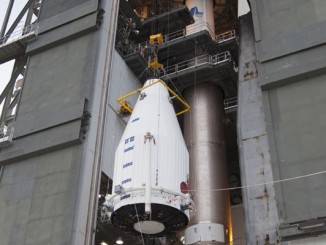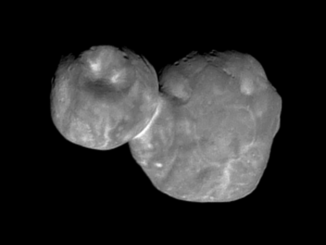
CAPE CANAVERAL — The 100th rocket in America’s Evolved Expendable Launch Vehicle program, the current fleet of boosters used by the nation to get its critical assets into space, was rolled to the pad this morning for a vital mission on Saturday.
The United Launch Alliance Atlas 5 rocket will lift the GOES-R geostationary weather observatory into orbit for NASA and NOAA, departing Saturday during a one-hour window that opens at 5:42 p.m. EST (2242 GMT).
At 10:56 a.m. EST (1556 GMT) today, the 197-foot-tall launcher was wheeled from its assembly building to the Complex 41 pad at Cape Canaveral aboard a mobile platform to begin final pre-flight preparations.
A seven-hour countdown is planned Saturday, and weather forecasters predict a 90 percent chance of allowable launch conditions.
The EELV program was created 20 years ago as the next-generation families of rockets to launch all of the U.S. national security spacecraft, from the smallest weather satellites to the world’s largest eavesdropping birds, performing the full spectrum of spacelift operations.
With seed money from the Air Force, Lockheed Martin created the Atlas 5 and Boeing formed the Delta 4, and both families made their debut launches in 2002. United Launch Alliance merged the once-rival rockets under a single corporate banner in 2006 that enhanced the sharing of mission data, blended a common workforce and streamlined engineering and design efforts.
ATLAS 5 — 66 launches *
-25 flights dedicated to the Defense Department
-15 commercial missions
-13 for the National Reconnaissance Office
-13 for NASA
DELTA 4 — 33 launches *
-18 flights dedicated to the Defense Department
-10 for the National Reconnaissance Office
-5 commercial missions
* to date
EELV has launched at least 633,000 pounds of cargo into space, and that’s not counting 27 flights with classified payload masses that likely push the total close to one million pounds in 99 flights.
At the outset, the Air Force’s requirements for the new EELV program specified mass-to-orbit capabilities, vehicle reliability, launch pad infrastructure and standard payload interfaces with the vehicles.
The Atlas 5 and Delta 4 would replace all of the Atlas 2 and 3, Delta 2, Titan 2 and 4 rockets, satisfying the needs of the Air Force through modular rockets that could be tailored to any given payload through adding or subtracting solid-fuel strap-on boosters and various payload fairing sizes.
“The investment the government made with Lockheed Martin and Boeing to develop launch systems that satisfied our unique requirements yielded a tremendous capability for our nation. These launch vehicles came on board to support, in essence, the recapitalization/improvement of all our mission areas: precision, navigation and timing; early missile warning; satellite communications; space control and intelligence, surveillance, reconnaissance,” said Dr. Walt Lauderdale, technical director of the EELV generation and operations division within the Air Force’s Launch Systems Enterprise Directorate at the Space and Missile Systems Center in Los Angeles.
“Since the attacks on 9/11 and the subsequent military action, these new capabilities provide critical support to our men and women serving across the globe. From a personal perspective, I’m honored to have had the opportunity to do my part to deliver these capabilities over the last 11 years.”
The Atlas 5 is powered by the NPO Energomash RD-180 kerosene-fed main engine, Aerojet Rocketdyne solid rocket boosters for augmented takeoff thrust, and topped by the venerable Centaur upper stage that uses an Aerojet Rocketdyne RL10C-1 liquid hydrogen/liquid oxygen engine. The payload is encapsulated in either a ULA four-meter-wide aluminum or a RUAG Space five-meter-wide composite shroud, each available in three different lengths.
Delta 4 burns liquid hydrogen and liquid oxygen in both of its stages, with Aerojet Rocketdyne making the RS-68A main engine and RL10B-2 upper stage powerplant, and Orbital ATK manufactures the strap-on solids. ULA makes four-meter-wide and five-meter-wide composite fairings and Boeing builds a tri-sector aluminum fairing for certain government missions.

The inaugural launch for EELV came on Aug. 21, 2002, when an Atlas 5 carried a European television satellite to orbit for Eutelsat. The new era for U.S. rockets continued that November when the first Delta 4 blasted off carrying another commercial spacecraft for the same Paris-based operator, giving both EELVs a paying passenger on their debuts.
The first Air Force satellite flew on the third flight, sending up a communications satellite for the troops in March 2003 atop a Delta 4.
The next major milestone in the program occurred in December 2004 when the heavy-lift version of Delta 4, a triple-barreled booster to carry the largest and heaviest payloads, soared on a test flight to iron out the bugs before the costliest national assets were entrusted to the vehicle on subsequent flights.
It was a fortuitous decision to conduct such a demonstration without a real satellite onboard. A phenomenon, called cavitation, caused bubbles to form in the liquid oxygen plumbing that fooled instrumentation into thinking the tanks were running empty, shutting down the main engines prematurely.
The condition was thoroughly analyzed and corrected, allowing Delta 4-Heavy to assume the big payload launches from the retiring Titan 4 rocket, fulfilling one of the primary purposes for EELV.
With both the Atlas 5 and Delta 4 designed as modular systems, the military was able to phase out its reliance on the medium-class Delta 2 and Titan 2, the intermediate Atlas 2, heavy-lift Titan 4 rockets and all of the vast infrastructure needed for the four different rocket lines.
Today, only the long-lived Delta 2 remains in service. It has two remaining NASA launches planned before full retirement.
“When established, the requirement for the EELV program was to meet all of the National Security Space spacelift requirements at a cost that was at least 25 and up to 50 percent less than the heritage programs (Atlas 2, Delta 2, Titan 2/4). To date, we are meeting that minimum threshold of 25 percent reduction in cost — to include a $4.4 billion reduction in the program as a result of negotiating the current contract with ULA,” Lauderdale said.

EELV was the path forward for military space, a collection of rockets built through just two systems to span the full range of needs the Pentagon could invision to keeping its constellations of communications, navigation and weather satellites flying high, plus delivering critical performance to the National Reconnaissance Office and its management of the overhead surveillance system for the U.S. government and civil science missions for NASA.
“ULA continues to provide our current launches to orbit, and we’ve seen those vehicle families be extremely successful — not just for national security space, but for NASA and commercial customers. I believe that part of the recipe for success for both Atlas 5 and Delta 4 has its origins in the painful experiences from the late 90s, when both companies suffered significant launch failures: Lockheed Martin with Athena, Titan 4 and Centaur; Boeing with Delta 2, Delta 3 and the Inertial Upper Stage,” said Lauderdale.
“The sharp focus that these failures brought continued into the EELV program and contributed to the Air Force’s reinvigoration of mission assurance after the acquisition strategies of the mid-90s. That government focus on mission success was a big part of EELV’s strong record of success of Atlas 5 and Delta 4 over the past 14 years.”
After early EELV flights went only from Cape Canaveral in Florida, both rockets eventually took up residence at a second launch site — Vandenberg Air Force Base in California. While the Cape affords access to equatorial orbits, the West Coast base features the prominent path to polar orbits where some types of reconnaissance satellites like to go.
Atlas 5 has done 54 East Coast flights and 12 West Coast missions. The Delta 4 has flown 27 times from the Cape and six times from Vandenberg.
“I entered the Air Force in 1984 during the Cold War and President Reagan’s military buildup. After becoming the Atlas 5 program manager in 2005, at the other end of my military career, I had several opportunities to travel to Moscow to visit the RD-180 manufacturer. Walking around Red Square, unescorted, while visiting a Russian industrial partner, was quite an experience. I never imagined, during the 1980s, that I might be doing such a thing,” Laudersale said.
“Ahead of the first Air Force Atlas 5 mission (STP-1), we needed to clear any possible intersection between the Atlas RD 180 and with the failure of Sea Launch’s Russian Zenit booster from January 2007. We traveled to Moscow to hear from the manufacturer why they believed the RD-180 was still good to fly. Again, a very unique — and unexpected — experience for an Air Force officer who grew up during the Cold War.”
The RD-180 main engine, now a source of criticism, was first used by Atlas 3 through the urging of the U.S. government to assist Russian engineers following the Soviet Union’s collapse. But times are changing.
“The EELV program is entering a period of huge transition. In response to the Russian invasion of Crimea, the Department of Defense and Congress are united in the urgent need to eliminate our dependence on the RD-180,” said Lauderdale.
“The Air Force is using Public Private Partnerships with industry to spur the development of new engine technologies and eventually new launch vehicle systems. In less than 10 years, we will likely be flying solely on vehicle systems whose names don’t include Atlas or Delta.”
United Launch Alliance has just five more single-stick Delta 4-Medium+ rockets remaining on the manifest through late 2018 as the vehicle is phased out due to its uncompetitive cost.
The Delta name will live on through at least 2023, however, with the triple-body Delta 4-Heavy rocket serving the niche national security space market.
Technicians at the ULA factory in Decatur, Alabama, will build and stockpile the cores for five Heavy vehicles before the Medium’s retirement. Making the rockets now, then allowing the entire assembly line to shut down and simply storing the Heavy vehicles is the economic way to go, officials said.
2018
-Delta 4-Heavy with NASA’s Solar Probe Plus (Cape Canaveral)
-Delta 4-Heavy with NROL-71 (Vandenberg)
2019
-Delta 4-Heavy with NROL-44 (Cape Canaveral)
2020
-Delta 4-Heavy with NROL-82 (Vandenberg)
2021
-Delta 4-Heavy with NROL-68 (Cape Canaveral)
2022
-Delta 4-Heavy with NROL-70 (Cape Canaveral)
2023
-Delta 4-Heavy with NROL-91 (Cape Canaveral)
“By working early with ULA, we can establish the most efficient and cost effective arrangement for meeting our heavy lift requirements through the early 2020s,” Lauderdale said.
For the Atlas 5, however, NASA and commercial spaceflight will carry the rocket well into the 2020s as it launches humans and hardware into space. Astronauts heading to the International Space Station will ride atop the rocket in Boeing’s CST-100 Starliner capsules starting in the next two years and Sierra Nevada will use Atlas 5 to send the Dream Chaser mini-shuttle to the station on cargo-delivery missions.
Meanwhile, the U.S. military will transition to other rockets in the coming years — the SpaceX Falcon, United Launch Alliance’s Vulcan now being developed and possibly Orbital ATK’s proposed EELV-class boosters.
Despite the unparalleled success record, EELV gets a bum rap for not being cool.
“How can using big rockets to launch things not be cool? … The EELV program provides transportation services for our nation’s most critical satellites. It’s really about those payloads, not the rocket; we’re just the truck,” said Lauderdale.
Over the past 14 years, EELV has maintained the Global Positioning System with a dozen replenishment launches, assembled three brand new constellations of military communications satellites, deployed next-generation missile warning sentinels, boosted the reusable X-37B orbital spaceplane on four flights, supported the nation’s eyes and ears in space with new surveillance platforms and launched probes to the moon, Mars, Jupiter and Pluto.
Flight No. 100 on Saturday will launch America’s new advanced weather observatory that promises to revolutionize forecasting and improve the accuracy of warnings.
See earlier GOES-R coverage.
Our Atlas archive.



